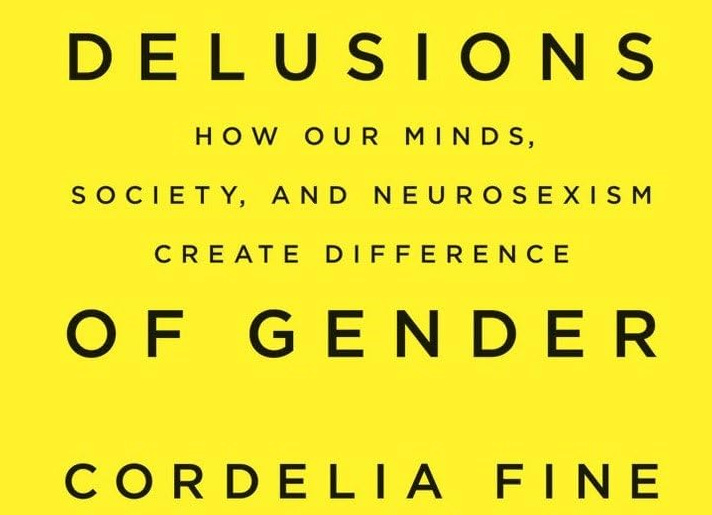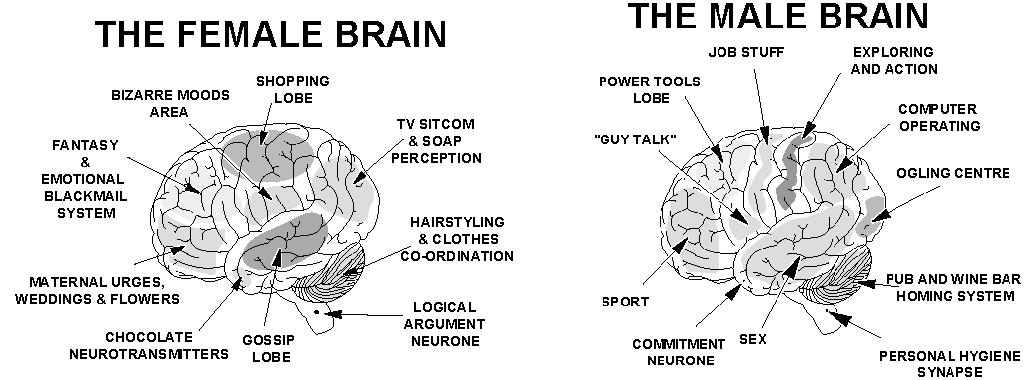Androgycrats
Part 2: Weaponizing weak and perverted men
through corruption, conformity, blackmail, and submission
Androgynopolis
The world needs bad men. We keep the other bad men from the door. — Rust Cohle The men of yesterday are never coming back. The transhuman agenda is not just one of species alteration at the DNA level, and iatrogenocide carnage at the reproductive level, it comprises a distinctive component of demolition through gender confusion and sex-specific trait dest…
Greek ἀνδρόγῠνος (andrógunos), from ἀνήρ (anḗr, “man”) + γῠνή (gunḗ, “woman”)
Note: This longer-than-normal sequel was going to be divided into a third part, but it works better as one.
Pain In the Brain
A recent study made headlines worldwide proclaiming that men’s and women’s brains work differently, just as honest psychologists and thoughtful wives and husbands suspected, for however long it has been since our species was bred here on earth. This was supposedly a “first-time” scientific discovery that perhaps shocked only those incapable of using theirs.
The study found that Artificial Intelligence can now distinguish male and female brain patterns and thoughts with 90% accuracy. The sex chromosomes we are born with help to determine the cocktail of hormones our brains are exposed to, particularly during early development, puberty, and aging. (Provided this exposure is not interrupted by demons posing as gender transition doctors and therapists who exploit mentally ill mothers with a penchant for child abuse)
Researchers have long struggled to connect sex to concrete differences in the human brain. That the technological capabilities to study these differences coincided with the ascension of militant feminism and a socially engineered war of the sexes didn’t help matters. Political correctness and self-censorship in the academy may have prevented certain impermissible topics from important inquiry, foremost among these are race and sex differences, where taboos illicit an absence of both curiosity and funding.
The neuroscience community had largely considered any observed sex-associated differences in cognition and behavior in humans to be due to the effects of cultural influences. Researchers who did venture down this path grappled with charges of “neurosexism,” or falling prey to embracing stereotypes or being too quick to interpret human sex differences as biological rather than what they absolutely must be without questioning—cultural.
Cultures are malleable. Societies can be reengineered. Biology not so much.
In a world of academic activists, the latter must be denied.
Advances in brain imaging technology showed decades ago profound evidence of neurobiological differences. Still, sociologists and psychologists refused to accept the evidence, preferring to feel smug in their denunciations of any research findings that challenged their political bias, while leveling accusations of bias and prejudice against their more courageous colleagues for daring any scientific undertaking.
Every few years the screeching of feminists against this subject comes in the form of an activist book by academic “scholars.” The most recent iteration by British feminist neurologist (oxymoron?) Gina Rippon seeks to muddy the waters around conclusive research findings. Her book The Gendered Brain follows Angela Saini’s 2017 Inferior and Cordelia Fine’s 2010 Delusions of Gender in the latest faux-academic category of “neurosexism” which has obfuscated attempts to understand sex differences at the brain level.
It has all the cherry-picked wahhmen-as-victim-of-the-patriarchy slants to politically appeal to a feminist audience. Rippon begins with an 1895 quote from social psychologist Gustave Le Bon, who used his portable cephalometer to declare that women “represent the most inferior forms of human evolution.” She even taps Google engineer James Damore who privately shared with co-workers the psycho-biological roots for the absence of women in tech and leadership roles. You might recall that sharing these milquetoast and widely-accepted psychological and biological facts cost Damore his job.
What do these female activist authors have in common?
They aim to blame society and culture for established neuro-biological gender differences and set out to distort sex, gender, and the biological roots of these differences as the product of “bad research,” the fault of continued “stereotypes” in our “sexist society,” which engenders…“neurosexism.”
In other words, any findings by researchers must be the product of neurosexism and not scientific discovery. And those who set out to research this politically fraught topic had better watch out, lest they want to be accused by pseudoscientist feminist activists as “neurosexist!”
If we could simply reengineer society in such a way that Good Citizens don’t notice any gender differences at all then we could all live in one brave new genderless utopia. Right?

Research into the psychological and behavioral differences between males and females provides a foundation for understanding how sex may influence certain traits, based on empirical studies that highlight average differences. These findings offer insights without suggesting “neurosexist” judgments about the behaviors or capabilities of either sex. The key point to remember when reading this compilation is not to make it personal as either a man or woman or assume personal anecdotal evidence disproves these “average differences.”

(References & studies at the end.)
Neuroscience research reveals that the human brain exhibits sex-based anatomical and functional differences. For instance, adjusted for brain size, females’ hippocampi, critical for learning and memory, are larger and function differently than those of males, whose amygdalas, crucial for emotion processing and memory, are larger and also function distinctively.
Studies, including a brain scan experiment of individuals viewing emotional content, showed sex-dependent activity in the amygdala, critical for emotional memory, highlighting implications for mental health issues such as depression and anxiety, which are more common in women while ASD and schizophrenia are more common in boys and men.
The two hemispheres of women’s brains communicate more than men’s, while male activity is more coordinated into local regions emphasizing the necessity of integrating sex differences in neurological research to better understand and treat psychological disorders. These and other neuro-biological differences also explain social and behavioral differences.
Men exhibit higher levels of physical aggression than women, though mostly toward other men. Women are more prone to passive-aggressive behavior, toward both men and women, the latter who instigate competitive desires which can manifest through “shade” formerly known as “gossip.” This difference in aggression and passive-aggression is attributed to both biological influences, such as hormonal factors, and socialization process preferences.
In terms of risk-taking, men show a greater propensity for engaging in behaviors with potential negative outcomes. A meta-analysis by Byrnes et al. (1999) and research by Harris, Jenkins, and Glaser (2006) confirm men’s higher likelihood to take physical and financial risks, linked to evolutionary and social factors, including competitiveness as a motivator for mate attraction.
Men’s hyper-competitiveness, both physically and financially, is deeply rooted in psychobiological factors that are tied to evolutionary pressures. Historically, physical prowess was essential for male competition over resources and mates. In modern sedentary societies, while the physical aspect of competition has diminished, financial competition has emerged as a critical replacement, often reflecting an individual’s ability to accumulate resources and secure a higher social status. This aligns with the concept of hypergamy, or the female preference for partners of higher socioeconomic status, a strategy that maximizes reproductive success and stability.
According to Buss and Schmitt’s Sexual Strategies Theory (1993), men adapt their competitive strategies to meet female mate preferences, which historically favor resource-rich or high-status males capable of supporting offspring.
From an anecdotal ethnographic perspective how many “tech bros” are physically soft, even displaying effeminate traits who have no interest in physical dominance or even self-improvement but have amassed enough riches to have their pick of attractive females who otherwise would never give them the time of day?


2010: Mining bitcoin from your double wide.
2024:

Women report and exhibit higher levels of emotional expressivity, especially regarding sadness, fear, and empathy. Women also express a broader range of emotions more freely and have a heightened ability to recognize and respond to others’ feelings. While these are important traits in understanding other humans’ health and well-being (even suffering), they may not be the most effective for decision-making in leadership roles.
Case Study Sidebar
Two decades of Sweden’s feminist governing policies destroyed that country. By taking “refugee” empathy to the level of submission in signaling their tolerance for and cultural acceptance of foreign and unassimilable newcomers the demographics of Sweden have changed forever. Sweden is essentially gone. They’re just waiting for the sociocultural returns to come in over the next few decades. Imams in Malmö and Gothenburg openly boast that Sweden will be a Muslim-conquered nation within two generations. The effeminate men of certain political stripes (socialist-communist-liberal-green) and the cadre of feminists in local and national leadership roles were happy to surrender a nation once inhabited by savage Vikings.

This image of Swedish politicians in hijabs says everything. Imagine if Swedish Christian men asked Swedish women to be more chaste and modest in their attire and even to cover up their hair. There would be screeching accusations of misogyny and toxic masculinity perpetuating patriarchy that must be destroyed. They cannot logically see how they imported an actual patriarchic culture that they have already submitted to.
After two generations of replacing the native Swede with African and Arab-born “Swedes,” the native Swedish women are (mostly) happy to submit to a foreign culture that treats women as submissives. The irony of this double standard is lost on their feminist and socialist (libtarded) brains. The problem is much larger than women, or neurobiological sex differences, as historically a nation’s women are only as permissive as its men allow them to be. Worse still, a nation of people without morals, values, or convictions (God, country, family) can be manipulated to accept anything as a replacement.
Who else is behind the destruction of Sweden and other European nations? You’d better not notice Good Citizens, or you might lose your bank account.
End Case Study Sidebar
Communication styles also differ, with women using language more for social connection, while their conversational strategies often emphasize affiliation and support, contrasting with the more assertive, pointed, and independence-oriented communication observed in men.
Spatial abilities present an area where men typically outperform women, particularly in tasks requiring mental rotation and spatial navigation. Interest patterns between sexes show men gravitating more towards systems and things, while women prefer people and relational activities, as confirmed by Su, Rounds, and Armstrong (2009) and Lippa (1998). These distinctions are evident in educational and career choices affecting the distribution of sexes across fields, as mentioned by James Damore to his colleagues at Google.
Understanding the importance of empirical evidence in discussions about sex differences, helps us talk about them, rather than shy away from them for politically convenient reasons.
To sum up this entire non-debate, the differences in male and female brains are highly compatible and complementary when working together to optimize and extract each other’s strengths. In short, women’s brains are said to be wired for empathy and intuition, whereas male brains are more wired to be optimized for reason and action.
Weaponizing Weak Men






















